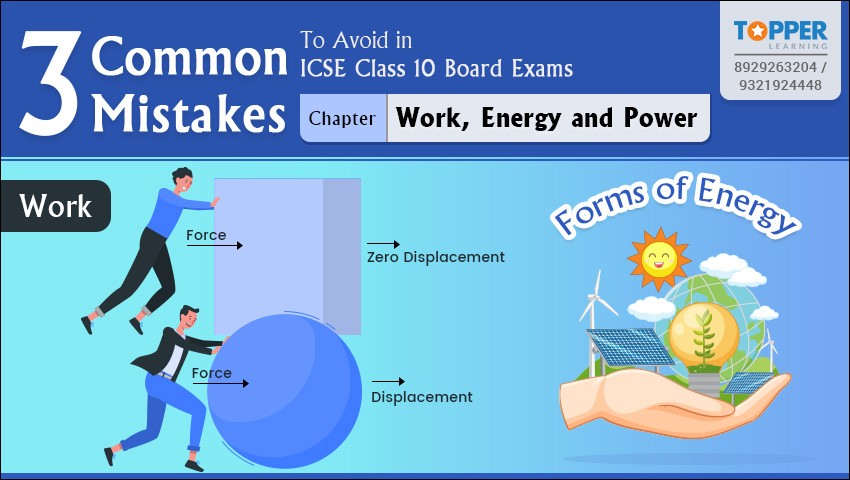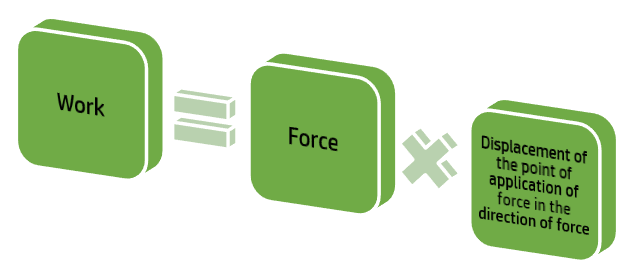3 Common Mistakes to Avoid in ICSE Class 10 Board Exams - Chapter Work, Energy and Power

Work, Energy & Power is an important chapter from ICSE 10 Physics Syllabus. This blog will help you understand the mistakes students make while attempting this chapter, their origins, and what concept you must be thorough with to avoid them.
By Topperlearning Expert 01st Feb, 2024 | 11:03 am
ShareIntroduction
In the usual sense, work means any sort of physical as well as mental activity which we perform. Activities like eating, reading, writing, typing, walking, etc. are all considered to be work. But in Physics “Work” has a different meaning. In Physics, work is done only when an object or body moves under the influence of force. The body must undergo the displacement. If there is no displacement, there is no work. The amount of work done by a force is equal to the product of the force and the displacement of the point of application of the force in the direction of force.
Here are some areas of the mistakes, students must avoid while writing their answers for the questions on the chapter Work, Energy & Power.
Mistake 1: Errors while writing the definition of unit Kilowatt hour.
For example: While answering questions such as “Define a kilowatt hour. How is it related to joule?” students made this simple error which must be avoided.
- The energy possessed by a body is measured by the amount of work that the body can perform.
- The energy of a body is its capacity to do work.
- Energy is a scalar quantity.
- The units of energy are same as that of work.
- The SI unit of energy is Joule (J) and the CGS unit of energy is erg.
- Commercial unit of electrical energy is kilowatt hour (kWh).
- Kilowatt (kW) is the unit of power while kilowatt hour is the unit of energy or work.
|
Student’s mistake in the solution: Mistake while writing the definition: One kilowatt hour is the energy by a source of power 1kW in one hour (1000 W in 3600 s).
Mistake in the relation between kilowatt hour and joule: 1 kWh = 103 J |
The correct solution should be: One kilowatt hour is the energy spent/ or work done by a source of power 1kW in one hour (1000 W in 3600 s) Or it is the work done when 1 kW power is consumed for one hour or any statement to this effect. 1kW h = 3.6 x 106 J or 1 kW h = 3.6 M J |
Mistake 2: Error in work done during the circular motion.
For example: While answering questions such as “A satellite revolves around a planet in a circular orbit. What is the work done by the satellite at any instant? Give a reason.” Students attempt some simple mistakes due to unclarity in the concepts. Read the below points to avoid this mistake.
- There is no transfer of energy if a body is acted upon by a force normal to the direction of its displacement.
- A body moving in a circular path, centripetal force is normal to its displacement and work done is zero i.e., there is no transfer if energy.
|
Student’s mistake in the solution: Work done is zero as the displacement is zero. Although the answer i.e., work done is zero is right but reason stated in the above line is incorrect because in the question it is asked about the “work done by satellite at any instant”. |
The correct solution should be: Zero force/centripetal force (of gravity) is always perpendicular to the displacement. OR W = Fs cos 90 W = 0 |
Mistake 3: Error while writing examples for conversion of energy from one form to another.
For example: While answering questions such as “Give one example of each when: (i) Chemical energy changes into electrical energy. (ii) Electrical energy changes into sound energy.” students made this simple error which must be avoided.
-
Conversion of electrical energy to sound energy: In loudspeakers, electrical energy is received in the form of electrical signals from the microphone and these signals are then converted to sound energy. In an electric bell, the electric current flowing through the circuit is used to produce sound.
-
Conversion of sound energy to electrical energy: A microphone converts sound energy into electrical energy.
-
Conversion of electrical energy to chemical energy: While charging batteries, electrical energy is converted to chemical energy. An electrolytic cell is a cell that converts electrical energy to chemical energy.
-
Conversion of chemical energy to electrical energy: A battery is a DC voltage source that converts chemical energy to electrical energy.
|
Student’s mistake in the solution: i) Cell ii) Microphone/bell
|
The correct solution should be: i) Dry cell ii) Loudspeaker/ Electric bell In the solution for part (i), students need to mention the type of cell as not doing so will make it unclear for an examiner to identify whether you are talking about electrolytic cell or dry cell. And this will lead to a deduction in marks. |
Questions for You
If you want to practice more questions from this chapter, then you can utilise the "Ask a Doubt" feature. Here, you will get a set of good questions that have been asked by the students and which are answered by experts. Initially, you can practice solving these questions on your own and if you find them difficult to solve or if you are stuck at any step then you can review the expert's detailed solution. Below are a few questions that you can practice:
- A child of mass 35 kg is sitting on a trolley of mass 5 kg. The trolley is given a push by applying a force such that it begins to move with a speed of 4 m/s. The trolley comes to rest after covering a distance of 16 m. Find (i) the work done on the trolley (ii) the work done by the trolley before coming to rest.
Hint: We know that kinetic energy possessed by a moving body is equal to the amount of work which the moving body is capable of doing before coming to rest.
K.E. = ½ mv2
Click here for detailed solution to this question - An elevator is designed to lift a load of 1000 kg with a uniform velocity of 2m/s. What will be the power of the elevator?
Hint: The rate of doing work is called power. The power spent by a source is measured as the amount of work done by the source in one second (or it is equal to the rate of doing work)
Power = Work done/ time = Force x displacement/ Time = Force × velocity
Click here for detailed solution to this question - A car of mass 2 kg is moving with speed of 10m/s. Calculate work done to stop it?
Hint: By the work-energy theorem, work done on a body is equal to a change in kinetic energy.
Click here for detailed solution to this question
Conclusion
By avoiding these common mistakes and developing a deeper understanding of the related concepts, students can improve their scores in exams. Keep checking this space for more such tips for other chapters from the ICSE Class 10 Physics Syllabus . Hope these strategies will help you to tackle these mistakes effectively and enhance your concept understanding.
Also, check out our free resources and learning materials. At TopperLearning, we bring you unique e-learning experiences, providing quality resources to students all over the country. The study materials are available for CBSE, ICSE, and Maharashtra Board alongside the resources for competitive exams like JEE and NEET.
More from Education
Important Resources
- Education Franchisee opportunity
- NCERT Solution
- CBSE Class 9 Mathematics
- NCERT Solutions for class 10 Science
- Sample Papers
- CBSE Class 9 Science
- NCERT Solutions for class 10 Maths
- Revision Notes
- CBSE Class 10 Hindi
- CBSE Class 10 English
- CBSE Class 10 English
- CBSE Class 10 Social Studies
- CBSE Class 10 Science
- CBSE Class 10 Mathematics
- Career In Science After 10
- Career In Commerce After 10
- Career In Humanities/Arts After 10
- NCERT Solutions for Class 10
- NCERT Solutions for Class 11
- Business Studies Class 12 CBSE project





